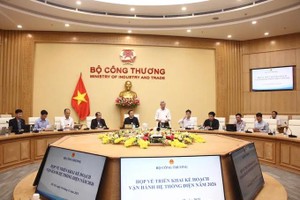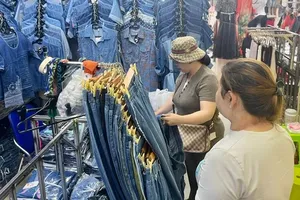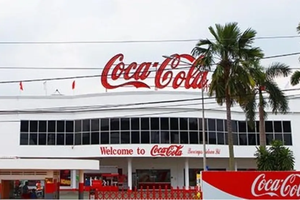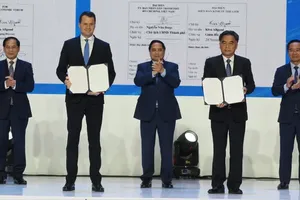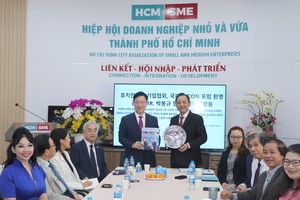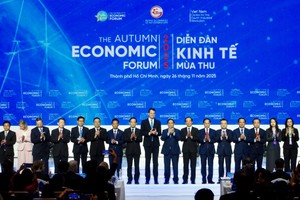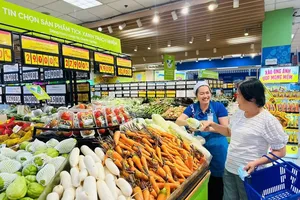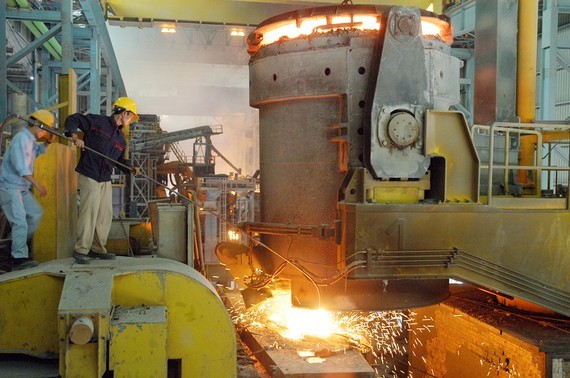
Impressive profits
According to the business result of Vietnam Steel Corporation (VNSteel), the company exceeded its plan last year, with some main targets even posting slight growth compared to the previous year. Specifically, the company achieved a net revenue of more than VND78.17 trillion last year. Of which, the parent company got VND2.48 trillion, equal to 163.8 percent of the plan for 2020. Pre-tax profit reached VND891 billion. Total consolidated revenue hit VND30 trillion, achieving 100 percent of the plan, and pre-tax consolidated profit touched VND260 billion. This year, the company plans to produce more than 2.5 million tons of steel billets, up 6.5 percent compared to last year.
Similarly, Hoa Phat Group is the leading enterprise in the construction steel segment, increasing its market share from 26.2 percent in 2019 to 32.5 percent in 2020. In the steel pipe segment, the two largest enterprises - Hoa Phat and Hoa Sen - raised their market shares from 31.5 percent to 31.7 percent and from 15.3 percent to 16.8 percent, respectively. As for the galvanized steel sheet market, Hoa Sen continued to confirm its dominance by increasing its market share from 29.5 percent to 33.4 percent. Although the business results for the whole year have not been announced, according to the business results in the first three quarters of last year, the profit of Hoa Phat Group jumped by 56 percent over the same period, exceeding VND8.84 trillion. Hoa Sen Group also reported its after-tax profit at VND1.15 trillion, three times higher than that in the same period in 2019, much higher than the plan set for last year.
Meanwhile, figures of the Vietnam Steel Association (VSA) also show the same situation as the business community. Last year, steel enterprises sold a total of 23.45 million tons of steel of all kinds, an increase of 1.4 percent compared to 2019. Construction steel slid by 1.2 percent but still accounted for the largest proportion of 44.6 percent in total consumption structure by steel category. Noticeably, Vietnam’s steel exports were over 8 million tons, with an estimated value of more than US$4 billion. The volume of steel products exported to the Chinese market rocketed by more than 20 times higher than in 2019. According to VSA's assessment, besides the positive signals from the export market, domestic consumption also recovered robustly from the second quarter of last year when construction activities returned to normal. Because Vietnam controlled well the Covid-19 pandemic, and construction of many public investment projects started, helping the steel industry to reverse the situation.
Several opportunities for the steel industry
According to experts, besides the positive signals from enterprises, and several policies to stimulate demand for infrastructure, positive export signals will be the highlight of Vietnam's steel industry this year. Steel demand is estimated to increase by about 3-5 percent compared to last year. Especially, key projects, such as the Eastern North-South Expressway, Trung Luong-My Thuan-Can Tho Expressway, and Long Thanh International Airport, will have a high steel demand. Besides, Vietnam also has opportunities to attract foreign direct investment capital flows, thanks to its ability to control the pandemic well and cheap labor costs. Therefore, when foreign enterprises enter the country, the demand for investment in factories and industrial parks will climb, pushing up the demand for construction steel.
Opportunities also come from the implementation of new-generation free trade agreements (FTAs), namely the Comprehensive and Progressive Agreement for Trans-Pacific Partnership (CPTPP) and the EU-Vietnam Free Trade Agreement (EVFTA), which is also expected to boost the steel industry to produce and export to new markets.
For CPTPP, the tariff removal will help Vietnamese steel enterprises expand export markets and import raw materials from advantageous countries, such as Australia. Currently, member countries in the CPTPP are the main suppliers of raw materials for steel production of Vietnamese enterprises. For example, Australia is the main supplier of coal and ore for Vietnam, accounting for 25.7 percent and 22.9 percent of the total import turnover of the country, respectively. Moreover, more than 50 percent of iron and steel scrap imported as raw materials for billet production are also from CPTPP countries. Some CPTPP members, such as Canada and Malaysia, also have great demand for importing finished steel products. In the past, the ASEAN and the US were the two largest importers of Vietnamese steel products. However, in the context of increasing protectionism, according to experts, it is necessary to switch and expand export to other markets, especially improve product quality to compete in the traditional market of competitors.
According to the business result of Vietnam Steel Corporation (VNSteel), the company exceeded its plan last year, with some main targets even posting slight growth compared to the previous year. Specifically, the company achieved a net revenue of more than VND78.17 trillion last year. Of which, the parent company got VND2.48 trillion, equal to 163.8 percent of the plan for 2020. Pre-tax profit reached VND891 billion. Total consolidated revenue hit VND30 trillion, achieving 100 percent of the plan, and pre-tax consolidated profit touched VND260 billion. This year, the company plans to produce more than 2.5 million tons of steel billets, up 6.5 percent compared to last year.
Similarly, Hoa Phat Group is the leading enterprise in the construction steel segment, increasing its market share from 26.2 percent in 2019 to 32.5 percent in 2020. In the steel pipe segment, the two largest enterprises - Hoa Phat and Hoa Sen - raised their market shares from 31.5 percent to 31.7 percent and from 15.3 percent to 16.8 percent, respectively. As for the galvanized steel sheet market, Hoa Sen continued to confirm its dominance by increasing its market share from 29.5 percent to 33.4 percent. Although the business results for the whole year have not been announced, according to the business results in the first three quarters of last year, the profit of Hoa Phat Group jumped by 56 percent over the same period, exceeding VND8.84 trillion. Hoa Sen Group also reported its after-tax profit at VND1.15 trillion, three times higher than that in the same period in 2019, much higher than the plan set for last year.
Meanwhile, figures of the Vietnam Steel Association (VSA) also show the same situation as the business community. Last year, steel enterprises sold a total of 23.45 million tons of steel of all kinds, an increase of 1.4 percent compared to 2019. Construction steel slid by 1.2 percent but still accounted for the largest proportion of 44.6 percent in total consumption structure by steel category. Noticeably, Vietnam’s steel exports were over 8 million tons, with an estimated value of more than US$4 billion. The volume of steel products exported to the Chinese market rocketed by more than 20 times higher than in 2019. According to VSA's assessment, besides the positive signals from the export market, domestic consumption also recovered robustly from the second quarter of last year when construction activities returned to normal. Because Vietnam controlled well the Covid-19 pandemic, and construction of many public investment projects started, helping the steel industry to reverse the situation.
Several opportunities for the steel industry
According to experts, besides the positive signals from enterprises, and several policies to stimulate demand for infrastructure, positive export signals will be the highlight of Vietnam's steel industry this year. Steel demand is estimated to increase by about 3-5 percent compared to last year. Especially, key projects, such as the Eastern North-South Expressway, Trung Luong-My Thuan-Can Tho Expressway, and Long Thanh International Airport, will have a high steel demand. Besides, Vietnam also has opportunities to attract foreign direct investment capital flows, thanks to its ability to control the pandemic well and cheap labor costs. Therefore, when foreign enterprises enter the country, the demand for investment in factories and industrial parks will climb, pushing up the demand for construction steel.
Opportunities also come from the implementation of new-generation free trade agreements (FTAs), namely the Comprehensive and Progressive Agreement for Trans-Pacific Partnership (CPTPP) and the EU-Vietnam Free Trade Agreement (EVFTA), which is also expected to boost the steel industry to produce and export to new markets.
For CPTPP, the tariff removal will help Vietnamese steel enterprises expand export markets and import raw materials from advantageous countries, such as Australia. Currently, member countries in the CPTPP are the main suppliers of raw materials for steel production of Vietnamese enterprises. For example, Australia is the main supplier of coal and ore for Vietnam, accounting for 25.7 percent and 22.9 percent of the total import turnover of the country, respectively. Moreover, more than 50 percent of iron and steel scrap imported as raw materials for billet production are also from CPTPP countries. Some CPTPP members, such as Canada and Malaysia, also have great demand for importing finished steel products. In the past, the ASEAN and the US were the two largest importers of Vietnamese steel products. However, in the context of increasing protectionism, according to experts, it is necessary to switch and expand export to other markets, especially improve product quality to compete in the traditional market of competitors.

